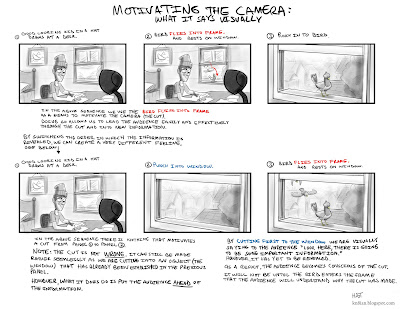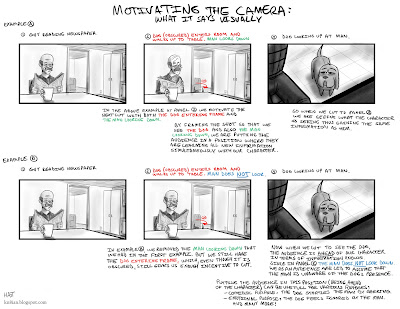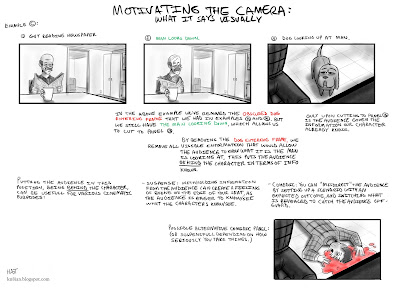Continuing with the previous post, these examples revolve too around motivating the camera, however explores more "what they are saying visually".

The next three examples are all slight variations of the same scene, each exploring a different approach in regards to the progression of information that is revealed to the audience, and consequently the effect it has on them. Please note that none of these examples are any more "right" than any other. They are merely different takes on the same scene. Their purpose is to show how slight variations in storyboards (and ultimately film) can produce vastly differing ideas/moods. Ultimately, it would all depend on what the script calls for or what is necessary of the scene to determine which of the following (if any) would be suitable.


I think the most important thing to take away from this concept of 'motivating the camera', is just to try and be conscious of the decisions you are making in your storyboards. Try to understand what you are actually saying visually, what information you are revealing to the audience (and when) and what effect it will have on them. Thinking about these things as you board can really help enhance a sequence and 'sell' an idea in the storyboard stage.
On a side note: None of these tips/theories/methods I've discussed are "rules". They are by no means absolute. There are no 'right' or 'wrongs' with storyboarding, as I've stated before, simply ways that work better than others at achieving desired responses. As much as I use these principles and incorporate them into my own sequences, I find myself quite frequently deviating, or cheating, or bending these ideas. I rely much more on the 'feeling' of a sequence as I board. Boarding panels and flipping through them to see how I 'feel' watching it, to see if the cuts are smooth, or if something doesn't 'feel' right. So take these tips for what they are worth, simply tips, tricks and principles I have found to be sucessful.
-Hat

9 comments:
some great, usefull boardtips Hat and a great blog!
I especially enjoyed the cubicle sagas.
man ... thanks soooooooo much for sharing as I have been wanting to dabble in boarding and get a better understanding of the process. this stuff is golden!
thanks so much again
thanks so much for sharing, great tips!
Hey Hat,
I really appreciate you sharing what you've learned about story boarding. I'm currently in a concept development class and there have been things my teacher has mentioned and explained, but didn't sink in for me. These posts you've been making have provided my "ahhh" moments. I understand! :)
Cheers
Riko
thanks! thanks! thanks! a tank of thanks for this blog!
Great tips, keep it up ! Really useful.
"good looking kid in a hat draws at a desk" ...
only if you're wearing one of the hats I made you =]
Thanks you so much for sharing your tips on storyboarding=)
Your explanations are clear and beneficial to us! I'll put these useful notes into practice!
Look forward to get inspired more from you=) Keep UP and wish you all the best!
Post a Comment